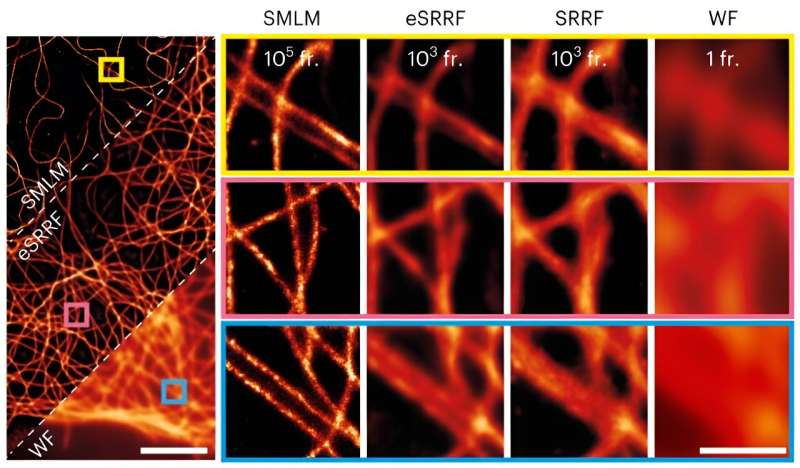This article has been reviewed according to Science X's editorial process and policies. Editors have highlighted the following attributes while ensuring the content's credibility:
fact-checked
peer-reviewed publication
proofread
The power to turn the invisible visible: A revolution in microscopy for live-cell imaging

Imagine having a microscope that magnifies and enhances the tiniest details, revealing a world beyond the limits of conventional resolution. That's precisely what enhanced super-resolution radial fluctuations (eSRRF) brings to the scientific forefront—an upgraded super-resolution magic wand for microscopes.
Building upon the success of the SRRF method, eSRRF is not just an evolution; it's a revolution. It takes microscopic imaging to the next level, delivering enhanced fidelity to the underlying structures and resolutions. eSRRF is brilliant, with automated data-driven parameter optimization. It determines the optimal number of frames needed for reconstruction, providing scientists hassle-free and efficient imaging experience.
Furthermore, eSRRF transcends dimensions by teaming up with multi-focus microscopy, leading to an era of 3D super-resolution. Imagine capturing volumetric snapshots of live cells at a breathtaking speed of approximately one volume per second. That's what the team developed.
Considering research openness and easy usability, eSRRF is designed with user-friendliness, seamlessly integrating with various microscopy techniques and biological systems, and researchers can now explore the microscopic realm without technological barriers.
Hannah Heil, a first author on the paper, explains that "eSRRF opens up new possibilities in live-cell imaging. It's not just about enhancing image resolution, with eSRRF, we empower researchers to optimize the results based on quantitative image quality measures. Our method provides researchers with a dynamic tool that adapts to their needs, making the invisible visible."
Ricardo Henriques, leading the Optical Cell Biology research group at the IGC, reveals that this new method "is a window into the future of scientific exploration. eSRRF can potentially revolutionize several fields, from biology to medicine, paving the way for discoveries that were once beyond our visual reach."
The findings are published in the journal Nature Methods.
More information: Romain F. Laine et al, High-fidelity 3D live-cell nanoscopy through data-driven enhanced super-resolution radial fluctuation, Nature Methods (2023). DOI: 10.1038/s41592-023-02057-w
Journal information: Nature Methods
Provided by Instituto Gulbenkian de Ciência (IGC)





















